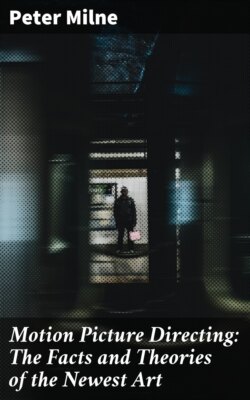Читать книгу Motion Picture Directing: The Facts and Theories of the Newest Art - Peter Milne - Страница 3
На сайте Литреса книга снята с продажи.
PREFACE
ОглавлениеTable of Contents
The observations on the art of directing motion pictures included in this book are not by any means intended as lessons for the layman with ambitions pointing him toward this goal. To teach the craft through the printed page is as impossible of accomplishment as instructing a steeple-jack in his trade through correspondence school. “A director must be born, not made.” This old adage, adapted to our present situation, is of a necessity partially false, inasmuch as at the time of the present day directors' initial birthdays there was no such thing as motion picture production. Still it is true in a sense. Because to direct for the screen requires a personality and an ability, blending so many elements of generalship and technique that to studiously acquire them is next to an impossibility.
Be that as it may, the motion picture of today is developing its own directors. It has reached out to all businesses and arts and drafted men who are now headed for top positions in the ranks of directorial artists. Besides it offers the most humble of the studio staff the opportunity to rise to the top.
During recent years cameramen, property men, authors, continuity writers, artists of brush and of pen and ink, actors and business men from varying lines have become identified with the art of motion picture directing. The law of averages has declared that many of these should fall short of success. Many have. But others have succeeded, have succeeded even beyond the expectations of their sponsors. Therefore it may safely be said that the gates to the field of motion picture directing are ready to open to all-comers, provided that the aspirants have the inborn abilities and personal makeup that are rigidly required.
These abilities, essential qualities and characteristics are dealt with in the following chapters by the undersigned who has spent nearly ten years in the motion picture industry, serving in the capacities of critic and continuity writer.
These abilities, essential qualities and characteristics are, therefore, set down here as first hand observations. But they are never intended as lessons that will produce immediate results in the way of lucrative positions. No reader of this volume can go dashing home to his eager wife with that much advertised greeting: “Dear! I've got that job! The New York Institute's book on directing produced 100 per cent results!”
It is hoped, however, that it will give those who have the patience to peruse it something of an insight into the tremendous responsibilities that rest on the shoulders of the conscientious director. At present most people seem to believe that that line on the screen: “Directed by ——” just stands for a lucky fellow having a grand and glorious fling within the walls of a motion picture studio.
Peter Milne.
With grateful thanks and appreciation for the views expressed therein by Marshall Neilan, William C. De Mille, Rex Ingram, Cecil B. De Mille, Frank Borzage, Edward Dillon, Ernst Lubitsch; and the representatives of D. W. Griffith, Thomas H. Ince, and other artists herein referred to, whose co-operation has made this book possible.
